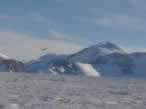An Adventurous Camp Move; Sujoy Departs
I write victoriously from the top of Buckeye Table, at our new camp a few miles to the southeast of Mercer Ridge! This is not a victory over nature by any means, as she has treated us very well and was only a bit grumpy today, but rather a victory over the demons of Twin Otter logistics!
The morning again was beautiful, and we received word that the otter had left around 1100h and would arrive by 1300h. About 30 minutes before their arrival, a small lenticular cloud began to form over Glossopteris. By the time they had arrived, the cloud had mushroomed and spread to thickly envelope the entire Buckeye Table… Of course it would happen! After a week of perfect weather and no logistical support, the day we finally got it the weather was bound for a change! Needless to say it was looking grim by the time the otter arrived, but the clouds appeared to be moving fast to the southeast, so we convinced the pilots to wait a few minutes to see what might happen.
Sure enough, a small window of blue opened exactly where we wanted to be – visible from down below. We hurried, scrambling together the rest of our camp for transport. Robert and Sujoy went first up to the top of the table, and Pete and I took down the rest of the camp for the second load. The clouds began to close in again, and it was a long time before the otter returned to fetch us and the rest of the camp. Pete and I were ready to hunker down, thinking we had been left to fend for ourselves by the already nerved-out pilots.
Finally they arrived, looking quite shaken from the first landing on the table. Apparently they thought they had found a good landing spot, but as they neared it, some enormous sastrugi emerged from nowhere and jostled the aircraft quite a bit. According to Robert, after the plane stopped, they were petrified for a moment – and then jumped out to closely inspect the plane. Apparently they hadn’t ever made such a dicey landing, and were almost certain it had resulted in damage to the tail. Robert said that upon the first jostling bounce, they could feel the tail dig in to the snow – which is never a good thing. This explained the absence, and the stricken-white faces of the pilots when they returned to fetch us.
We threw the rest of the boxes, tents, etc. into the otter, and belted ourselves in. We were treated to a dramatic fly-by of Treves Butte and Discovery Ridge as the lenticular clouds careened over the edges… Everything was obscured in and out of murk as we climbed over the edge of the table. A long, low circle revealed the base of Mercer Ridge and Mount Schopf, and the plane was brought down on a flagged-out runway that steered clear of the rollers which had nearly cached the plane on the first landing. The second landing was still rough… I had to tighten the cargo straps while belted in to keep the whole load from shifting and pinning Peter and I in the back of the plane, and had to brace the load with my legs and the virtual free-moving sled on top with my hands. Peter ducked down and braced against the back of my seat which was in front of him, and we touched down. The precautions may not have been necessary, as the second landing was a bit smoother – but seeing the sled and the load lurch towards me wasn’t an overly welcome sight.
The props stopped spinning and were latched up by the co-pilot, and we jumped out of the otter. The second load found itself on our new campsite almost immediately, and the relieved pilots were ready to go. Sujoy had his personal gear plus his sleep-kit loaded into the now empty otter (with the exception of some retro), and we said our goodbye’s. It was sad to see him go, as he was certainly a great man all around – with insightful conversation skirting any topic that may come up, a wonderful attitude, and genuine appreciation for nature and fieldwork. I look forward to seeing Sujoy soon, as Hal and I are to help analyze samples in Sujoy’s noble gas laboratory at Harvard University.
Robert, Peter and I set up camp, and got the grub going. It is noticeably colder today, perhaps that is a function of the increased altitude. We are now living at 2060 meters, a bit over 6,000 ft, which is a similar height above sea level as Mount Washington. However, due to the low-pressure anomaly over Antarctica, the atmospheric and physiological effects are more around 7,650 feet. This is probably responsible for the curious cloud patterns around here, as the cloud stratum occurs quite a bit lower than in New England, where the barometric pressure is a bit closer to the mean.
Now dinner is eaten, and I am a bit tired from the tear down and put-up of camp. I am sure looking forward to exploring this region in the next few days. The bedrock geology appears a bit different than the lower stratigraphy, and the morphology and climate has allowed for the growth of several alpine glaciers on the ridge. It will nice to look at local effects of climate change and these small glaciers streaming from the highlands. It will require a change in thinking from the continental-scale ice sheet, to small sensitivities to local conditions (which are very curious). But now it is time for bed – goodnight!

